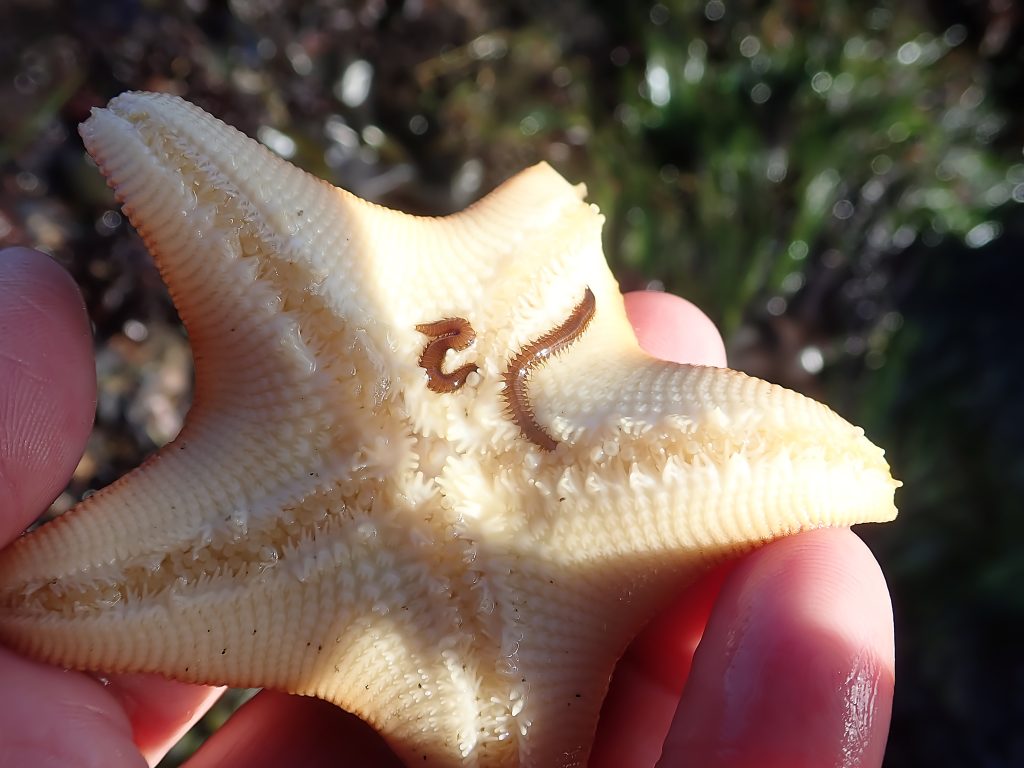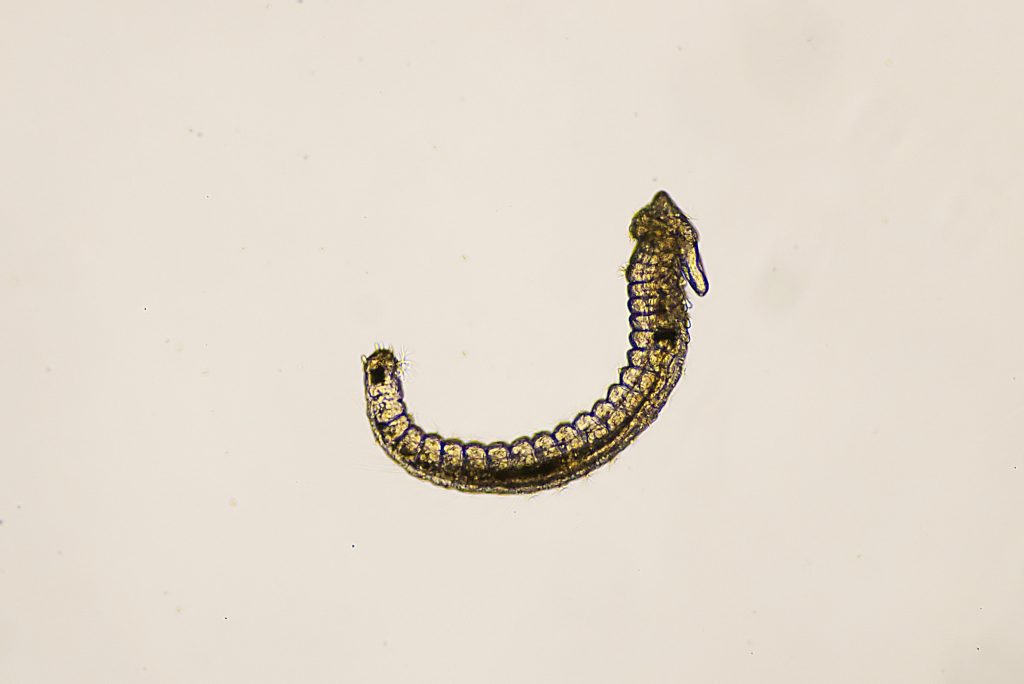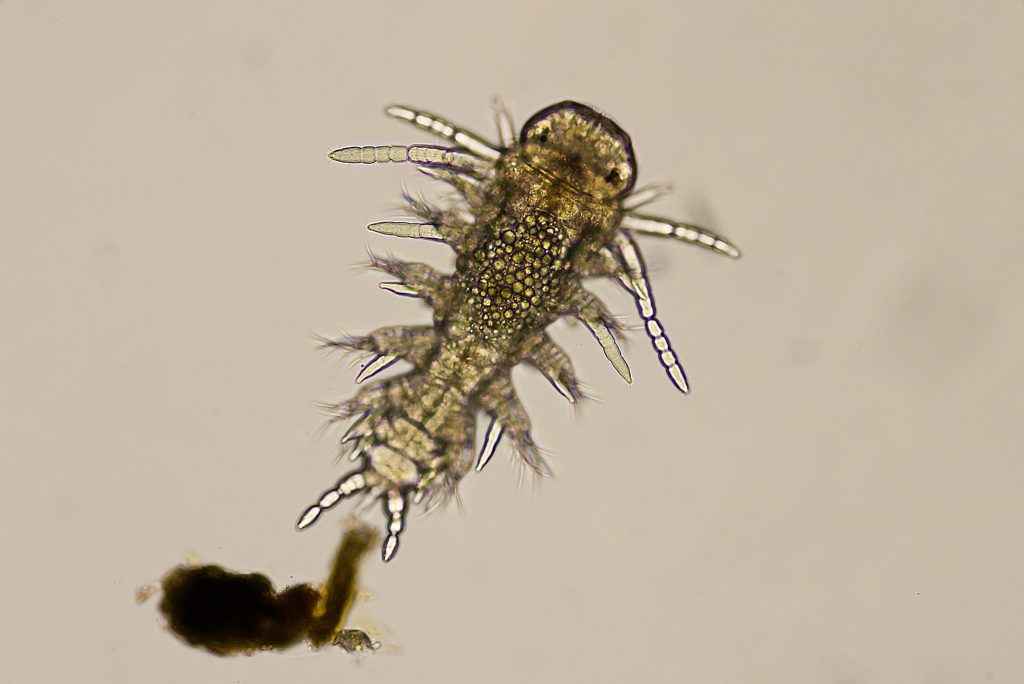Yesterday, 30 June 2023, was deemed by the National Museum of Natural History to be International Polychaete Day, and the Smithsonian had an entire day of talks and activities for visitors to learn about the marine segmented worms. And you know me: I’m in favor of any event that draws attention to the animals that are not like us. So this is my own little celebration of worms I encountered over this past week.
Living with sea stars
I’ve written before about how many of the bat stars (Patiria miniata) I see at Pigeon Point carry small commensal polychaetes on their oral surface, often associated with the ambulacral groove. Several taxa of echinoderms are known to have associations with polychaetes, and I’ve seen worms crawling around on sea stars, sea urchins, and sea cucumbers. Oxydromus pugettensis is the polychaete I’ve seen on the bat stars in the field.

2018-06-01
© Allison J. Gong
Years ago now, I collected some bat stars to bring back to the lab. Some of them had worms, and I was interested in seeing how long the worms stuck around once the stars were in captivity. The answer was “Not very long.” I seem to remember that the stars had lost their worms within a week. And since then, despite having many bat stars come through my hands at the lab, none of them have acquired worms.
Until now. This past week I was moving stars around and cleaning tables after flushing seawater pipes. I have a large bat star and a smaller one running feral in one of the tables. I picked up the larger star and turned it over just to check on it, and saw a dark squiggly thing. It was a worm!

2023-06-26
© Allison J. Gong

2023-06-26
© Allison J. Gong
Can you see the dark squiggle on the oral surface?
Here’s a close-up of the worm:

2023-06-26
© Allison J. Gong
This is the first time I have ever seen a sea star acquire a commensal worm. It’s gotta happen, because we see worms on stars in nature. But I do wonder about this relationship. The worms are highly mobile and probably leave one star and join another quite frequently, or remain free-living (i.e., not on a host star). I had brought in some algae the previous week, and it’s quite possible that the worm came along as bycatch and found its way to the bat star. I checked on the star later in the week, and did not see the worm. It hadn’t joined the smaller of the bat stars, either.
Baby worms
This past Monday I did a plankton tow off the end of the Santa Cruz Municipal Wharf. This was my first plankton tow of the year, and I wanted to see what was there. The water was very clear and the phytoplankton were lacking, but there was a decent diversity within the zooplankton. Of particular interest to this report were the baby worms.
Baby worms are present in any plankton tow collected at any time of the year, although they may be more abundant at some times compared to others. Clearly there isn’t much seasonality to reproduction in some of our local polychaetes. The most commonly seen baby worms in plankton samples are the metatrochophores of worms in the family Spionidae.
Adult spionids are benthic and live in tubes. They have two long palps that extend from the anterior end and are typically used to scrape up organic deposits from the area surrounding the tube. Like most polychaetes, spionids are broadcast spawners that cast gametes out into the water, where fertilization and development occur. Polychaetes go through a larval phase called a trochophore, defined by a ring of cilia (the prototroch) that produces the feeding current for the animal. Incidentally, many molluscs also go through a trochophore stage, but that’s a story for another time. Some polychaetes, including the spionids, have a second planktonic stage called a metatrochophore. The metatrochophore is a much larger and more elaborate version of the trochophore, with eyespots and few to many segments complete with associated bristles. They can crawl as well as swim. Some of them can be 3 mm long, which is pretty big for something that is still up in the plankton. The spionid metatrochophore also has the two long palps, which sometimes remind me of the flaps on Elmer Fudd’s hat.
These are photos of the same individual worm. It’s about 2 mm long, a little longer if all stretched out.

2023-06-26
© Allison J. Gong

2023-06-26
© Allison J. Gong
There was another type of polychaete metatrochophore in the sample, but I don’t recognize which family this one comes from. I should, because I see it frequently enough to know it isn’t unusual. It might be a young phyllodocid metatrochophore, but that’s just a guess. Anyhow, this creature has fewer segments than the spionid metatrochophore and lacks the spionid’s long palps. It does have eyespots, segments with bristles, and (I think) two pairs of tentacles associated with the head region. This individual also contains a lot of oil droplets, visible as those small dark circles in the dorsal half of the body behind the head. Oil droplets serve as energy stores and flotation devices. Many marine invertebrate larvae stockpile calories as they feed and store them in oil. In some cases, these calories are needed to sustain a later larval stage that doesn’t feed.

2023-06-26
© Allison J. Gong
There you have it, my belated contribution to International Polychaete Day 2023. I always enjoy finding worms in our plankton. They have a lot of personality, and it’s fun to watch them zooming around. They are really fast swimmers, and I have to squash them under a coverslip—just a little—to get them to hold still long enough to take photos. Always worth the effort, though!

I found a nice polychaete specimen at the Santa Cruz small craft harbor on June 10. I don’t know if this comment will allow me to attach photos so I will provide a link, The last image is a GIF showing the blood circulation.https://www.inaturalist.org/observations/166720060